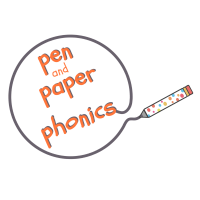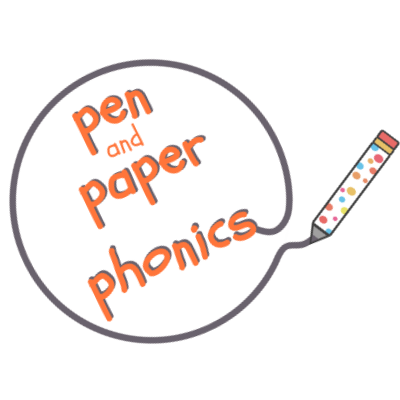
Learning ‘tch’ is a fun way to increase the number of words a child can read or spell independently.
‘tch’ is a spelling choice for the /ch/ sound, and it is called a ‘trigraph’.
This activity is great for introducing this ‘tch’ spelling choice, and for giving some extra practice in reading words with this trigraph.
New to penandpaperphonics.com? Click here to find out more.
Background to the ‘tch’ trigraph
(Or, jump straight to the activity)
A trigraph is a three letter sound. These are not as common as digraphs but they follow the same rule – more than one letter working together to spell one sound.
For example, the word ‘catch’ has three sounds in it: /c/ /a/ /ch/, but it is spelled with five letters, because the last sound /ch/ is spelled with three letters ‘t’ ‘c’ and ‘h’.

‘Tch’ is therefore a spelling choice for the /ch/ sound.
A helpful rule to remember is that ‘tch’ comes straight after one short vowel, and is most often at the end of a word. For example, in the word ‘hatch’, the short vowel sound ‘a’ is followed by the /ch/ sound, and so the spelling choice is ‘tch’. But, in the word ‘beach’ the vowel before the /ch/ sound is long, as in /ee/, and so the spelling choice for the end sound is ‘ch’.
There are not many trigraphs in the English language. When teaching them, ‘tch’ is a good place to start. This is because it contains the letters that students will have already come across for the /ch/ sound – ‘c’ and ‘h’.
Related Content: What is phonics?
TCH Stamp! Spelling Activity

The Basic Idea for TCH Stamp!
The basic idea of this activity is to use letter stamps and kinetic sand to sound out and spell words with the ‘tch’ spelling.
Kinetic sand is great for use with letter stamps because it holds the shape of the letter really well, so it can be read really clearly.
Students are using movement, touch and sight which are all great ways to learn, and combined together, they help to make sure a concept is remembered quickly and for longer.
The reason this activity works in teaching or reinforcing the ‘tch’ spelling is that it is a great way to reinforce the spelling at the end of a word, and to reinforce that it comes after a short vowel – as soon as the student has stamped a vowel, they are reaching for the ‘tch’.
Wondering if this activity will be suitable for your child’s reading level? click here for more information.
What you will need

- Letter stamps,
- Kinetic sand,
- A flashcard with ‘tch’ on it,
- A list of ‘tch’ words you want to practice, between 5-10 words is enough,
- Flashcards of these words – it’s best if the word is at the bottom of the card.
*In the resources section of this post, there are free printable word lists and flashcards.

How to play
- First, look at the flashcard with ‘tch’ on it. Teach or remind your child or student what it says – e.g. ‘tch’ says /ch/
- Read the flashcards, and note that the ‘tch’ spelling always comes after a short vowel sound.
Having introduced the ‘tch’ flashcard, you are ready to play:
- Lay out the kinetic sand in a tray (I use the lid of the box that I keep the sand in, but a small tray works well too):

- Choose a flashcard for your child or student to spell. The first time around, have the card where they can see it, and ask them to spell the word.


- Then, mix up the flashcards and choose one, without your student seeing it.
- Slip it under the sand or under the tray, so that it is not visible. (I’ve tried it by keeping the card in my hand and asking my student to spell the word in the sand, but I’ve found if I put it under the tray, they enjoy revealing it – it adds to the fun, which helps with the learning.

- With the card hidden underneath, ask your child or student to stamp out the letter sounds in the word.

- Then, ask them to scrape away the sand at the bottom of the tray to check if they were correct.

- Reset the tray and then continue until all the words are spelled.

To note
This is a fun and engaging activity. However, sometimes the sand is a distraction, as it is so good to play with! I often use ‘playing with the sand’ as a reward for when all the words are spelled. This means they get to play with the sand at some point, and it is not a distraction during the activity.
Also, when resetting the sand, students sometimes want to keep the ‘tch’ stamped in the sand and just change the beginning. This is not actually that helpful because they are not having the repeated action of writing the ‘tch’ spelling, so resetting all the sand is best, after each word.

How to Adapt
Change the Spelling Focus: This is a great activity to adapt, because all you need to do is change the spelling that you want to practice. For example, you could try it with CVC words, digraphs, magic e words, or words with blends.


Time it: Repeat the ‘tch’ activity above, but time it. Often after students have become familiar with the spelling they can enjoy being timed to see how fast they can stamp out the letters. This increases their speed in using this spelling choice.

Resources for TCH Stamp!
Downloads/Printables:
Resources for TCH Stamp! Activity
Related Content:
There are lots of phonics activities on this site. You might find this activity that uses the ‘ch’ spelling choice useful:
This Spellzone list is a good list of words that use the ‘ch’ and ‘tch’ spellings.
Is this ‘TCH Stamp!’ activity right for my child?
Sometimes, it can be difficult to know if an activity will be helpful for your child or student. For this activity, the questions below might help:
- Is your child reading regular, one syllable words correctly, through sounding out or by sight?
- Do they know that ‘ch’ says /ch/?
- Can they read other sounds such as ‘th’ and ‘sh’?
- Do they know how to read blends, such as ‘st’ and ‘mp’ in ‘stamp’?
- Can they spell regular, one syllable words, using the letter sounds above?
- Do they know that vowels can make a short sound (e.g. /a/) and a long sound (e.g. /ay/)
If the answer is ‘yes’ to these questions, then this activity will be a great way to learn or practice the ‘tch’ spelling pattern





